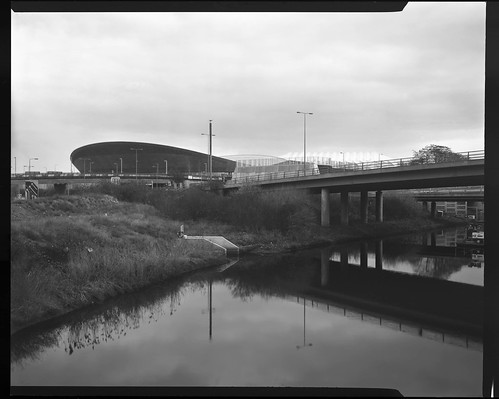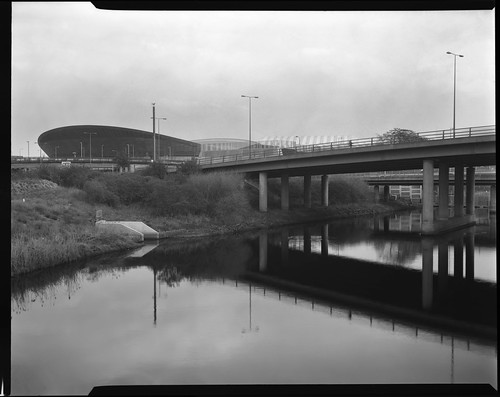Most photographic films still in use today are panchromatic, that is, sensitive to the spectrum of all visible light. However, the earliest photographic emulsions were only sensitive to blue light; the sensitivity of emulsions was first extended to be orthochromatic (sensitive to all but red light), before becoming panchromatic. Some manufacturers still produce orthochromatic films (such as
Adox Ortho, the film I first used with my large format camera) but for many years the primary use of orthochromatic film was for graphic arts applications as a result of being high contrast and fine grained, applications such as preparing black and white artwork for printing: these processes have been entirely superseded by digitisation.
 |
| Kodagraph Ortho Negative ON4 Reproduction Film |
I bought this box of
Kodagraph Ortho Negative Film ON4 in a batch of orthochromatic films and plates (which also included boxes of
Kodalith Ortho Film Type 3 and
Kodak Orthochromatic plates). The ON4 box was already opened and the only one of the three that was in a size that would fit any of my cameras without modification. Searching on the internet for information about the Kodagraph ON4 film, I found a
Kodak data sheet for the Type 3 film, and plenty of references to Type 3 on forum posts and so forth, but there seemed to be nothing about ON4. The label on the box calls it 'Reproduction Film'; it has a catalogue number 326 2680 and a 'develop before' date of 9/1982, as well as instructions to open under Kodak Safelight No.1/No.1A, i.e. a red or light red safelight.
Opening the box under a red safelight, two things were immediately apparent. The film does not have notches to identify which is the emulsion side, like most sheet film; examining it under the safelights, one side looked a lighter grey which I thought could be the emulsion side. There is also the possibility that the film doesn't have an
anti-halation layer (no colour came out during pre-soaking) meaning that it wouldn't matter which side is used. Loading it into the film holders, the film base is much thinner than other sheet films I've used, and I initially picked up two sheets together before I realised that how much thinner it is.
 |
| London 2012 Olympic Site, shot on Kodagraph ON4 rated at 6 ISO, developed in Rodinal 1:120 |
I shot the film using my
MPP Micro Technical camera. I rated some sheets at 12 ISO and some at 6 (the box does not list a speed rating, the data sheet for the Kodalith Type 3 film gave 12 ISO with 'pulsed xenon' and 8 ISO for tungsten; I assumed that the ON4 film would be similar, given it was designed for similar applications). Those shot at 6 ISO were better but perhaps a little underexposed. I tray developed the film by inspection under safelights in the darkroom, using Rodinal, diluted to 1:120 with the intention of controlling the contrast. Once developed, the clear areas of the negative are remarkably transparent, with almost no discernible base fog, perhaps surprising for film 30 years out of date, but slower film tends to take longer to lose sensitivity.
For a second test shoot, I pre-exposed some of the film in the darkroom using an enlarger. Ansel Adams in
The Negative describes using pre-exposure to improve shadow detail in high contrast scenes; I wondered if this would work for high contrast films. This can be done either in camera, or in the darkroom when loading the film. I exposed a sheet of film under an enlarger as a test, to find the shortest exposure which gave a discernible density on the film. I shot a number of sheets of the same subject, both with and without pre-exposure. However, the negatives from this second shoot I took out of the developer far too soon, with the result that they were all extremely thin, and as a result I haven't attempted to scan any of these. Part of the difficulty of tray developing film under a safelight is the fact that despite being able to see the image appear on the film as it develops, the film is still opaque until it is fixed, by which time it's too late to decide it needs longer in the developer, and this opacity can make the image appear denser than it is.
 |
| London 2012 Olympic Site, shot on Kodagraph ON4 rated at 5 ISO, developed in Rodinal 1:100 |
For the third test shoot I rated the film at 5 ISO, and again I pre-exposed some sheets. I also shot some Fomapan 400 at the same time, for a meaningful comparison of the Kodagraph ON4 with a panchromatic film. When these were developed I couldn't discern a difference between those with and those without pre-exposure, but having tray developed the film, I hadn't used consistent times so the testing regime wasn't really rigorous enough to tell. I diluted the Rodinal to 1:100 this time, which may have made the results a little higher in contrast than my first tests, but the lighting conditions were different too. The negatives are noticeably a little uneven, which can been seen in the sky, an issue due to not agitating the film sufficiently while developing.
 |
| London 2012 Olympic Site, shot on Fomapan 400, developed in Rodinal 1:50 |
The two films have very different looks, although the lighting conditions changed as I shot the Fomapan (which was shot with a yellow filter with to add some contrast in the sky, as well as pulling up tones in the foliage; I haven't tried ON4 with a yellow filter). The ON4 has a colder, harder look, which might suit architectural subjects for example. It also has extremely fine grain, and the slow speed is not necessarily an issue with large format film, large format cameras usually being used with a tripod.
 |
| Kodagraph ON4 rated 5 ISO, developed in Ilford Multigrade 1:30 |
I also developed some sheets in Ilford Multigrade paper developer, which I had used for developing the test to establish a minimum density for the pre-exposure. I diluted the Multigrade initially at 1:14, but, seeing the first sheet develop very quickly, I diluted the developer further, to roughly 1:30. The resulting negatives are very high contrast, losing detail in both highlights and shadows. This was to be expected, and, I imagine, closer to the results the film was designed to achieve.
References:
Ansel Adams, The Negative, 1981 ISBN 0-8212-1131-5





Thank you for sharing this valuable info!
ReplyDelete